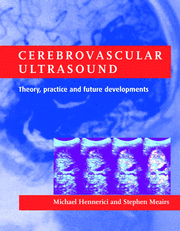Book contents
- Frontmatter
- Dedication
- Contents
- List of contributors
- Preface
- PART I ULTRASOUND PHYSICS, TECHNOLOGY AND HEMODYNAMICS
- PART II CLINICAL CEREBROVASCULAR ULTRASOUND
- (i) Atherosclerosis: pathogenesis, early assessment and follow-up with ultrasound
- 8 Morphogenesis of the atherosclerotic plaque
- 9 Hemodynamics and atherosclerosis
- 10 Carotid artery intima-media thickness
- 11 Non-invasive evaluation of endothelial function with B-mode ultrasound imaging of flow-induced brachial artery reactivity
- 12 Plaque characterization and risk profiles
- 13 Natural history of asymptotic carotid stenosis
- (ii) Extracranial cerebrovascular applications
- (iii) Intracranial cerebrovascular applications
- PART III NEW AND FUTURE DEVELOPMENTS
- Index
12 - Plaque characterization and risk profiles
from (i) - Atherosclerosis: pathogenesis, early assessment and follow-up with ultrasound
Published online by Cambridge University Press: 05 July 2014
- Frontmatter
- Dedication
- Contents
- List of contributors
- Preface
- PART I ULTRASOUND PHYSICS, TECHNOLOGY AND HEMODYNAMICS
- PART II CLINICAL CEREBROVASCULAR ULTRASOUND
- (i) Atherosclerosis: pathogenesis, early assessment and follow-up with ultrasound
- 8 Morphogenesis of the atherosclerotic plaque
- 9 Hemodynamics and atherosclerosis
- 10 Carotid artery intima-media thickness
- 11 Non-invasive evaluation of endothelial function with B-mode ultrasound imaging of flow-induced brachial artery reactivity
- 12 Plaque characterization and risk profiles
- 13 Natural history of asymptotic carotid stenosis
- (ii) Extracranial cerebrovascular applications
- (iii) Intracranial cerebrovascular applications
- PART III NEW AND FUTURE DEVELOPMENTS
- Index
Summary
Introduction
Studies using ultrasound to characterize carotid bifurcation plaques in asymptomatic and symptomatic patients performed in the 1980s and early 1990s have suggested that echolucent plaques are associated with an increased risk of developing symptoms (Johnson et al., 1985; Sterpetti et al., 1988; Langsfeld et al., 1989; Bock et al., 1993; Geroulakos et al., 1993). However, clinical decisions are still made using stenosis as the main criterion. This is because the association between local risk factors such as plaque echodensity and stroke have not been defined adequately. It was realized in the late 1990s that certain features of carotid atherosclerotic plaques are associated with an increased risk of stroke and can be determined non-invasively using high resolution ultrasound. The aim of this chapter is to review the literature on ultrasonic carotid plaque characterization and to provide an overview of current work in progress.
Carotid plaque characterization
Classification
High resolution ultrasound allows the investigator to visualize not only the lumen of the vessel but also arterial wall changes including the size and consistency of atherosclerotic plaques.
Early workers became aware of the great variability of plaque images. Several classifications have been proposed according to plaque consistency. One of the early classifications of plaque morphology was introduced by Johnston in the first study on the natural history of asymptomatic carotid stenosis using ultrasound (Johnson et al., 1985).
- Type
- Chapter
- Information
- Cerebrovascular UltrasoundTheory, Practice and Future Developments, pp. 173 - 183Publisher: Cambridge University PressPrint publication year: 2001



